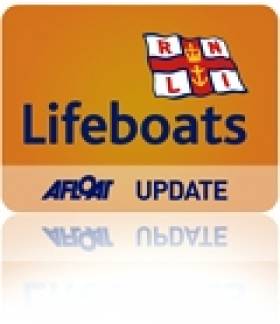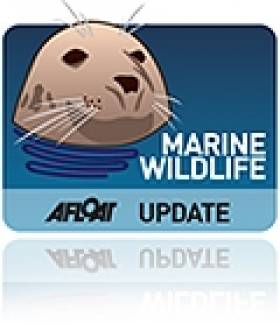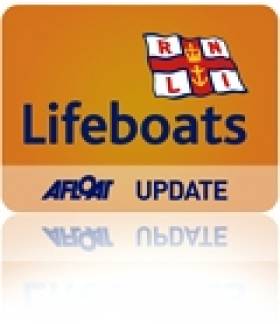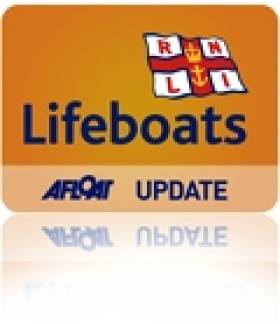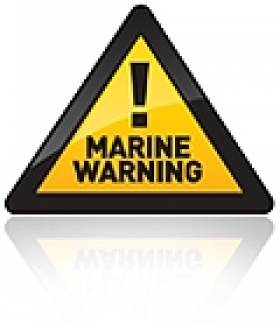Displaying items by tag: irish sea
Sea Trials Won't Weather New Shannon Class Lifeboat
#Lifeboats - The video above shows off a prototype of the RNLI's new lifeboat class, the Shannon, as it undergoes sea trials to determine how it handles the rough weather all too common to the seas around the UK and Ireland.
As previously reported on Afloat.ie, Irish naval architect Peter Eyre has been instrumental in the new lifeboat design, which is nearly 50% faster than the vessels currently in service.
It's also the second RNLI boat to be designed by an Irishman, after the Atlantic 21 developed in the 1970s by Cork-born Rear Admiral Desmond Hoare at the Atlantic College in Wales.
In other RNLI news, tributes were paid in the Isle of Man this week to the founder of the lifeboat institution in an annual ceremony on the Irish Sea island.
As BBC News reports, Sir William Hillary launched an appeal in 1824 that let to the formation of the RNLI, and he went on to serve as a member of the lifeboat crew at Douglas.
Dismay Over Britain's 'Lack of Ambition' Over Marine Conservation Zones
#MarineWildlife - Fears among conservation groups that the UK would enact just a quarter of the proposed Marine Conservation Zones (MCZs) in British waters have been realised with the news that just 31 out of a potential 127 sites will be designated as protected by the end of 2013.
The original proposals, as reported last year on Afloat.ie, cover the waters around the English and Welsh coastlines - of which only 1% is currently protected - recommending a variety of zones that offer different levels of protection for marine wildlife and plantlife, allowing flexibility for fishing and other activities.
A government decision on the conservation areas was already postponed in November last year after pressure from coastlines users.
But as the Guardian reports, Westminster has now been accused of a "lack of ambition" by the Marine Conservation Society (MCS) over the announcement on Thursday 13 December, which the charity says flies in the face of the government's own advisers who have recommended a 'coherent network' of sites around Britain, including the immediate designation for 59 sites regarded as 'highly threatened'.
"We cannot delay protection," said Jean-Luc Solandt of MCS. "We wouldn't stand by and let wildflower meadows and ancient forests be dug up and cleared, and yet heavy fishing gear is dragged across all kinds of habitats, destroying large swaths of the seabed with very little control."
The World Wide Find for Nature (WWF) added to the chorus of disapproval, saying the decision by the Department of Environment, Food and Rural Affairs (Defra) "falls woefully short of what is needed to protect the marine environment".
Ali Champion of WWF UK said: “It’s disappointing and shows a complete lack of commitment to the protection of our seas in a coherent way."
Of the four zones recommended for the Irish Sea area, only one - at Fylde Offshore, off Lancashire - has been chosen by Defra for protection. But as the Blackpool Gazette reports, local campaigners say they will vow to continue the fight to 'save our seas'.
Irish Sea 'Teeming' with Dolphins Says Wildlife Charity
#MARINE WILDLIFE - Large numbers of dolphins have been filmed in the Irish Sea off the Welsh coast by wildlife volunteers, as WalesOnline reports.
The conservationists with the Sea Trust charity, based in Pembrokeshire, recorded the "dolphin-fest" from the deck of the Stena Europe ferry en route from Fishguard to Rosslare.
Sea Trust director Cliff Benson confirmed the sighting of "a pod of eight Risso's dolphins, 40-plus common dolphins [and] four porpoises" among others as soon as the ferry headed west of Tusker Rock.
Altogether in the three-hour passage across the Irish Sea, the volunteer surveyors recorded a total of 99 common dolphins, 10 Risso's dolphins and 26 harbour porpoises. "That's not bad for a winter trip," said Benson.
He added that while there are threats to the Irish Sea's cetaceans from scallop dredging and the like, "to date our surveys show this area is teeming with life.
“This is Wales and Ireland we are talking about not Bermuda so get this amount of dolphin and porpoise activity with whales thrown in as well is incredible."
Stena has welcomed Sea Trust volunteers on board its vessels since 2004 to check on cetaceans and other marine wildlife in the waters between Ireland and the UK on a monthly basis.
And as reported previously on Afloat.ie, Seatruck Ferries has also been providing free passage to UK marine wildlife researchers to discover how many dolphins and seabirds make their home in the Irish Sea.
Meanwhile, BBC News reports that a pod of more than 100 bottlenose dolphins was recently spotted off the Isle of Man.
The Manx Whale and Dolphin Watch said it received a number of sightings from the east and west coasts of the island in the northern half of the Irish Sea, reporting a hive of activity.
"The group sizes tend to be relatively ginormous," said Tom Felce of the group. "So if they are here you can't miss them."
RNLI Receives Thank-You After Cow Rescued from Irish Sea
#LIFEBOATS - The volunteer lifeboat crew at Trearddur Bay in Anglesey, north Wales have received a kind donation and a thank-you card from the owner of Daisy, a cow recently rescued after falling from a cliff into the Irish Sea.
Danielle Bosustow, aged eight, was so touched that the crew had rescued her pet she put pen to paper to thank them. Her thank you card reads: "Thank you so much for your help rescuing my cow Daisy. I am so happy to see her again."
Along with the thank you card was a kind donation from Danielle’s grandfather, a local farmer who visited the station to show his gratitude to the RNLI.
The volunteer crew sprung into action on 22 October last, following reports that a cow had fallen from a cliff at Porthdafarch.
The lifeboat launched and with the help of the local farmer, Daisy was located and towed to safety using a bridle. She was taken to a bay close by where she could safely reach dry land.
Alf Pritchard, press officer for Trearddur Bay RNLI said: "We were shown some photographs which were taken after Daisy’s ordeal and it was good to see she is none the worse for her experience.
"It’s so nice when people come back to let you know that what you have done is appreciated. As a charity, the RNLI also very much appreciates the donation."
Laser Sailing Across the Irish Sea Video
UK Laser sailors Steve Cockerill and David Summerville embarked on a challenge of a lifetime last May when as they sailed Laser dinghies across the Irish Sea from from Howth (Ireland) to Holyhead (Wales) to raise funds for Mind and the John Merricks Sailing Trust. The total time involved was 13 Hours 37 Minutes, a distance of 115 nautical miles as this latest video reveals.
Isle of Man Lifeboat Volunteers Recognised by Queen
#LIFEBOATS - Volunteers with Douglas RNLI in the Isle of Man were presented with Diamond Jubilee medals from the Queen last week in recognition of their tireless service to saving lives in the Irish Sea.
And they couldn't have found a better place to present them than the Fort Anne, the former home of RNLI founder Sir William Hillary.
The medal recipients included lifeboat crew Neal Corran (Coxswain); Juan Howland (Emergency. Cox); Tony Radcliffe (Mechanic); Peter Cowin (Emergency Mechanic); Donald Bottomley Emergency Mechanic); Simon Bushe (Emergency Mechanic); Peter Washington (Emergency Mechanic); Emily Heaton; Richard Coase; J Noel Farrell; Mark Versluijs; Richard Forrest; Graeme Cushnie; and Nigel Smallwood; plus shore crew Mary Corran (LOM); Paul Cunningham (Head Launcher); Alex McBride (Winch Operator); Robert Corran MBE; John McCreadie; and Paul Zywicki.
UK Watchdog Slams Sellafield Nuclear Waste Handling
#SELLAFIELD - Radioactive waste stored at Sellafield poses an "intolerable risk" to the environment, according to the UK's National Audit Office.
RTÉ News reports that a new study from the British government department watchdog highlights the failure of successive operators of the UK's largest nuclear plant to properly dispose of waste from the facility over more than 50 years.
The complex, on the coast of the Irish Sea in Cumbria, is said to contain enough contaminated waste to fill 27 Olympic-sized swimming pools.
Conference Calls On UK Govt to 'Save Our Irish Sea'
#MARINE WILDLIFE - Marine experts are calling on the UK public to pile pressure on their government to create Marine Conservation Zones (MCZs) to help protect and restore marine wildlife in the Irish Sea and around the British coast.
The Living Seas North West Conference in Cumbria recently was a call to arms for marine experts and the public to join forces to protect the oceans.
And organisers the North West Wildlife Trusts used the event to press support for nature reserves in the Irish Sea as part of a UK-wide campaign by The Wildlife Trusts for 127 MCZs around the United Kingdom.
Callum Roberts, Professor of Marine Conservation at the University of York, described areas off the Isle of Man which have never been dredged as “carpeted with life”.
He said: “In the 19th century the Irish Sea bed was crusted with oysters. Today it is not just a sea different in the quantity of the wildlife it is different in the quality of the habitats in which that wildlife lives.”
Prof Roberts described how a study showed that dredging to catch 28,000 prawns also caught 12,000 other fish, most of which were thrown away. He also spoke of dives where he has seen the seabed damaged in huge areas by trawling.
“Over-fishing is not the only thing going on in the oceans," he said, "they are also affected by climate change and pollution. Our seas are changing faster than at any other time in human history.”
Prof Roberts said he was not against fishing, but that conservationists and the fishing industry need to find some common ground. “The prosperity of wildlife and the fishing industry depend on it," he said.
Meanwhile, The Wildlife Trusts marine protected areas manager Richard White spoke about the problems caused "by all the things that human activity is doing wrong".
He added: "We are trying to increase the resilience of our marine wildlife. The critical part is that we are doing this by trying to create Marine Conservation Zones.”
Pollution was highlighted by TV star and diver Paul Rose and Caroline Salthouse of the North West Coastal Forum.
“A huge problem is ocean debris," said Rose. "In 43 years of diving I am beginning to see more plastic and less fish. It is an issue that we must use to get people engaged in what is going on in our seas.”
Salthouse called for the public not only to sign the Wildlife Trusts’ new 'Petition Fish', but also to write to the British government as individuals.
More details about the Marine Conservation Zones and Petition Fish can be found at www.wildlifetrusts.org/living-seas
Late Night Mayday Response for Holyhead RNLI
#LIFEBOATS - Holyhead RNLI's all-weather lifeboat was dispatched late on Wednesday night (24 October) in response to a distress call from a yacht in the Irish Sea.
The volunteer crew received the request from Holyhead Coastguard after a mayday call from the skipper of a 24-yacht off the northwest coast of Anglesey in North Wales.
The man, who was the only person aboard the vessel, was on his way to the Canary Islands when he made the call for assistance.
A helicopter from RAF Valley stood by the casualty until the lifeboat crew arrived to rescue him and tow his vessel back to Holyhead.
The yacht reportedly started to sink as it was towed into Holyhead harbour, but the lifeboat crew managed to secure the vessel alongside the boatyard slip.
Marine Notice: Cable Laying in Irish Sea Between Wales and Portmarnock
#MARINE WARNING - The latest Marine Notice from the Department of Transport, Tourism and Sport (DTTAS) advises mariners of cable laying operations in the Irish Sea from next week onwards.
The cable laying operations between Wales and Portmarnock Beach in north Co Dublin will commence on Thursday 25 October for approximately 14 days, subject to weather conditions. The works will be undertaken from the C/S Resolute (Call sign V7FF3) supported by the M/V Coastal Discovery (Call sign PBUZ).
Both vessels will display appropriate shapes and lights during the operations, and will keep a listening watch on VHF Channel 16 at all times.
Mariners are particularly advised to note that small craft will also be supporting the main operations vessels in the immediate area of Portmarnock Beach. These craft will have VHF communications, and their movements will be co-ordinated by the main vessels.
In addition, divers will be operating between Portmarnock Beach and the cable laying vessel within the approved corridor for these work and to a maximum distance of 6.5km from the shore.
All vessels, particularly those engaged in fishing, are requested to give all vessels involved in these operations a wide berth.
Full details of co-ordinates are included in Marine Notice No 59 of 2012, a PDF of which is available to read or download HERE.



























